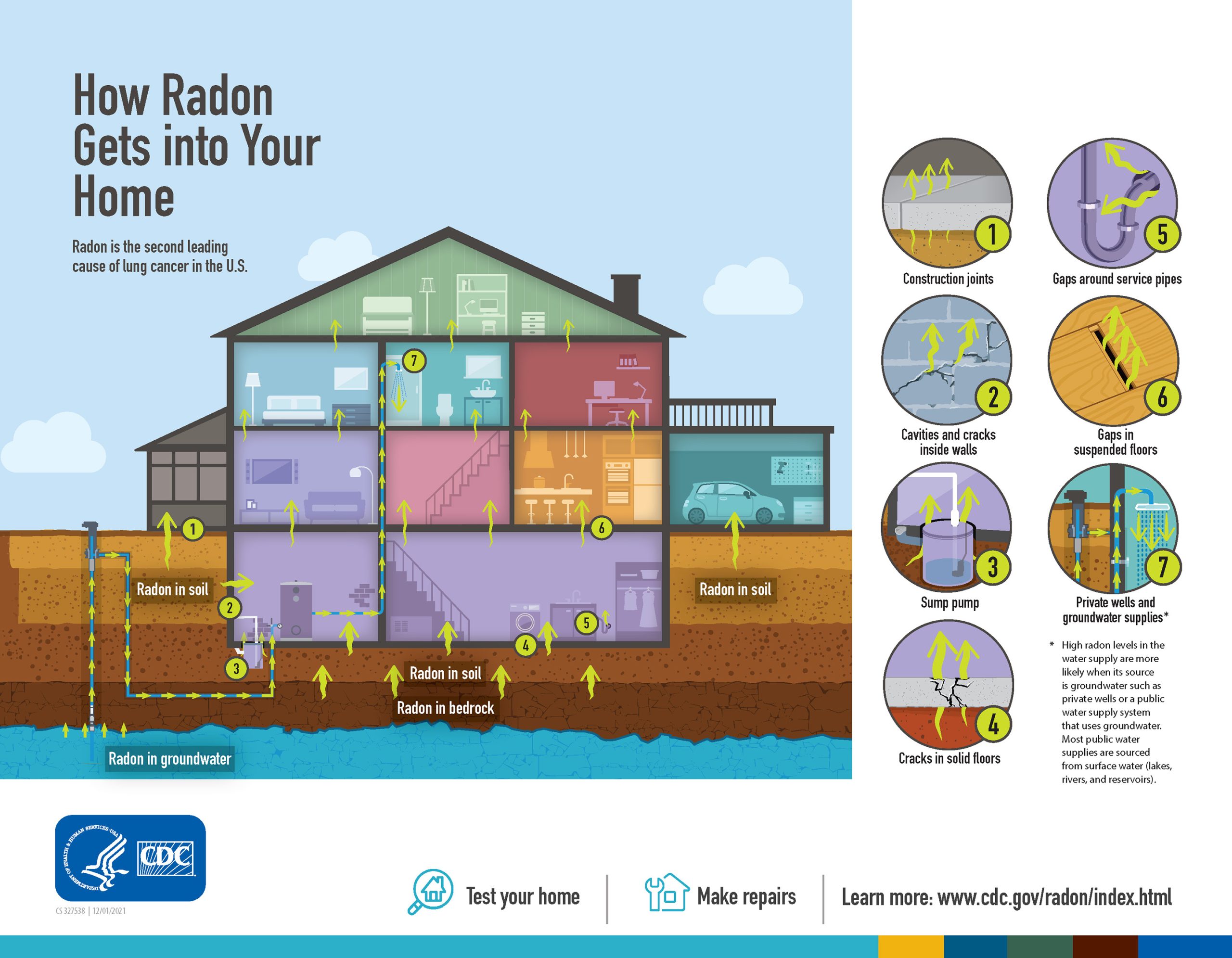Radon in Your Basement? Easy DIY Check Guide
Worried about elevated basement radon levels and the potential health risks? You're not alone. Many homeowners face this concern. This comprehensive guide provides a step-by-step approach to accurately testing for radon gas in your basement, understanding the results, and taking necessary action to protect your home and family.
Understanding Radon and Its Risks
Radon is a naturally occurring, colorless, odorless, and tasteless radioactive gas formed from the decay of uranium in soil, rock, and water. It can seep into homes through cracks in foundations, walls, and other openings, particularly in basements where it can accumulate. According to the EPA, radon is the leading cause of lung cancer among non-smokers in the United States, responsible for an estimated 21,000 deaths each year. Prolonged exposure to high basement radon levels is a significant health hazard, making regular testing crucial.
Why Basements Are More Susceptible
Basements, being underground or partially underground, are typically more susceptible to radon infiltration. The stack effect, where warm air rises and exits a building, creates a negative pressure that draws radon gas up from the soil into the basement. Poor basement ventilation can exacerbate this issue, trapping the gas and allowing it to reach dangerous concentrations. It's also important to remember that even homes with slabs can be affected, as radon can enter through cracks or gaps around pipes.
Methods for Detecting Radon in Your Basement
There are two primary methods for detecting radon: using a radon testing kit and hiring a professional radon measurement service. Both options have their advantages and disadvantages, and the best choice depends on your budget, time constraints, and desired level of accuracy.
DIY Radon Testing: Using a Radon Testing Kit
DIY radon tests involve purchasing a radon testing kit, deploying it in your basement for a specified period, and then sending it to a laboratory for analysis. These kits are relatively inexpensive and readily available at hardware stores, home improvement centers, and online retailers. There are two main types of DIY kits: short-term and long-term.
Short-Term Radon Tests
Short term radon tests are designed to provide a quick indication of radon levels. They typically involve deploying the kit for 2 to 7 days. While convenient, they are more susceptible to fluctuations in radon levels due to weather conditions or changes in ventilation. If a short-term test yields a result of 4 pCi/L (picocuries per liter) or higher, the EPA recommends conducting a follow-up test to confirm the results.
Long-Term Radon Tests
Long term radon test kits are deployed for 90 days or longer. They provide a more accurate representation of average radon levels over an extended period, mitigating the impact of short-term fluctuations. According to a 2024 study by the American Association of Radon Scientists and Technologists (AARST), long-term tests provide a more reliable assessment of basement radon levels and are recommended for making informed decisions about radon mitigation system installation.
Professional Radon Measurement Services
Hiring a certified radon measurement professional ensures accurate and reliable results. Professionals use calibrated equipment and follow strict protocols to conduct radon tests. They can also interpret the results and provide recommendations for radon mitigation system installation if necessary. The cost of professional testing varies depending on the location and complexity of the test, but it's generally a worthwhile investment for homeowners seeking peace of mind.
The table below compares the key features of DIY radon testing kit and professional radon measurement services.
| Feature | DIY Radon Testing Kit | Professional Radon Measurement |
|---|---|---|
| Cost | Lower | Higher |
| Accuracy | Dependent on test length and conditions | Generally more accurate |
| Convenience | High | Requires scheduling |
| Expertise | Requires following instructions carefully | Professional interpretation and recommendations |
Step-by-Step Guide to Using a Radon Testing Kit in Your Basement
This section provides a detailed guide on how to properly use a radon testing kit in your basement to ensure accurate and reliable results.
- Purchase a Radon Testing Kit: Choose a kit that is certified by your state's radon program or meets EPA radon guidelines.
- Select a Suitable Location: Place the test kit in the lowest lived-in level of your home, which is typically the basement. Choose a location that is not near drafts, exterior walls, or areas with high humidity. The kit should be at least 20 inches above the floor and away from objects that could obstruct airflow.
- Prepare the Area: Close windows and exterior doors for 12 hours before starting the test and during the entire testing period. Avoid running fans that exhaust air to the outside, except for normal operation of air conditioning systems.
- Deploy the Test Kit: Follow the instructions provided with your specific test kit. Typically, this involves opening the container and placing it in the designated location for the specified duration (2-7 days for short-term tests, 90+ days for long-term tests).
- Record the Start and End Dates: Accurately record the start and end dates and times of the test on the provided form. This information is crucial for accurate analysis.
- Seal and Mail the Kit: After the testing period, seal the kit according to the instructions and mail it to the laboratory for analysis.
- Receive and Interpret the Results: The laboratory will send you a report with the radon level in picocuries per liter (pCi/L). If the result is 4 pCi/L or higher, the EPA recommends taking steps to mitigate the radon levels.
Interpreting Radon Test Results and Taking Action
Understanding your radon test results is critical for making informed decisions about your home's safety. The EPA has established guidelines to help homeowners interpret their results and determine the appropriate course of action.
| Radon Level (pCi/L) | Recommended Action |
|---|---|
| Below 2 | No action needed, but consider retesting periodically (every 2-5 years). |
| 2-4 | Consider mitigation, especially if there are risk factors such as smoking or a family history of lung cancer. |
| 4 or Higher | Mitigation is strongly recommended. Contact a qualified radon mitigation system professional. |
It's important to note that even radon levels below 4 pCi/L pose some risk. The EPA suggests that homeowners consider mitigation if levels are between 2 and 4 pCi/L, as there is no safe level of radon exposure. If your test results indicate elevated basement radon levels, it’s vital to consult with a certified radon mitigation system specialist to explore mitigation options.
Radon Mitigation Techniques
A radon mitigation system is designed to reduce radon levels in your home. The most common technique is soil suction, which involves installing a pipe through the foundation and venting radon gas from beneath the house to the outside. Other techniques include sealing cracks and improving basement ventilation. The cost of mitigation varies depending on the size and construction of the home, but it is a worthwhile investment to protect your family's health.
FAQ: Frequently Asked Questions About Radon Testing
- How often should I test my basement for radon? The EPA recommends testing every two years, especially if you live in an area with known radon problems. Test again after any renovations that could affect radon levels.
- Can I test for radon myself, or do I need a professional? You can use a radon testing kit for a DIY test. However, professional testing offers greater accuracy and expert interpretation of results.
- What is the acceptable level of radon in a home? The EPA recommends taking action if radon levels are 4 pCi/L or higher.
- Does basement ventilation help reduce radon levels? Yes, improving basement ventilation can help to lower radon concentrations, but it's usually not sufficient as a sole mitigation method for high radon levels.
- What are the long-term health effects of radon exposure? Long-term exposure to radon is the leading cause of lung cancer in non-smokers.
Testing for radon gas in your basement is a proactive step towards ensuring a safe and healthy living environment. By understanding the risks, choosing the right testing method, and interpreting the results accurately, you can take appropriate action to protect your family from the dangers of radon exposure. Share your experiences or ask questions in the comments below – your insights can help others facing similar concerns!


